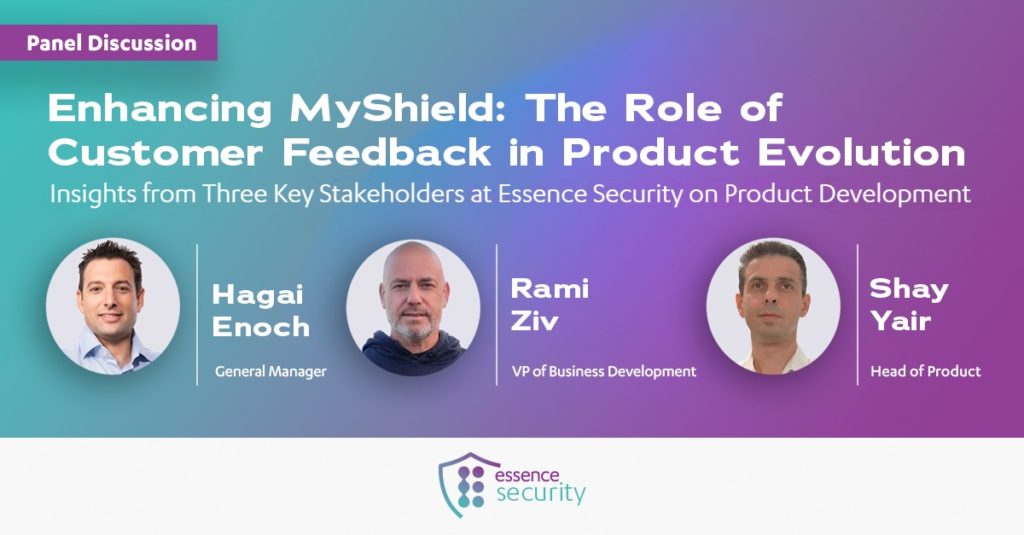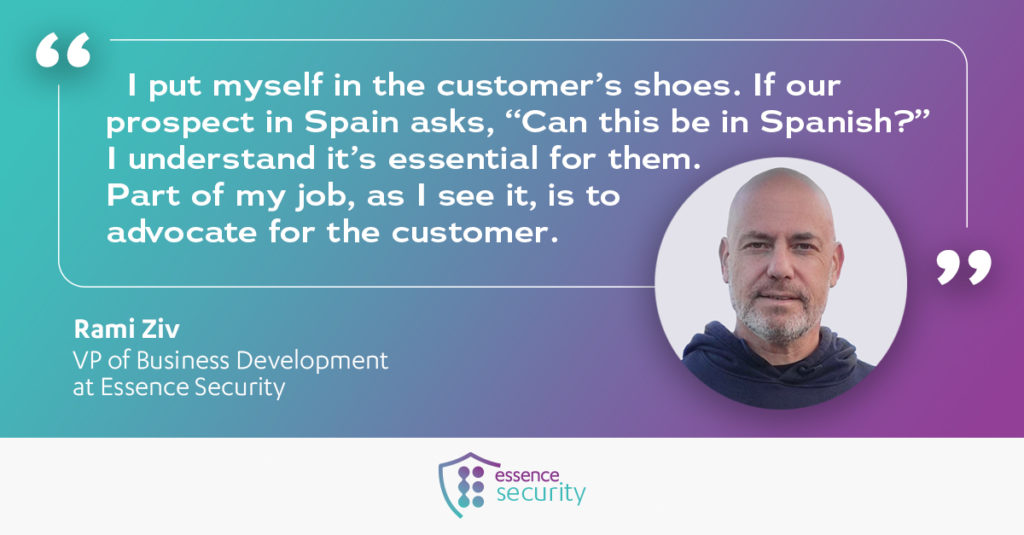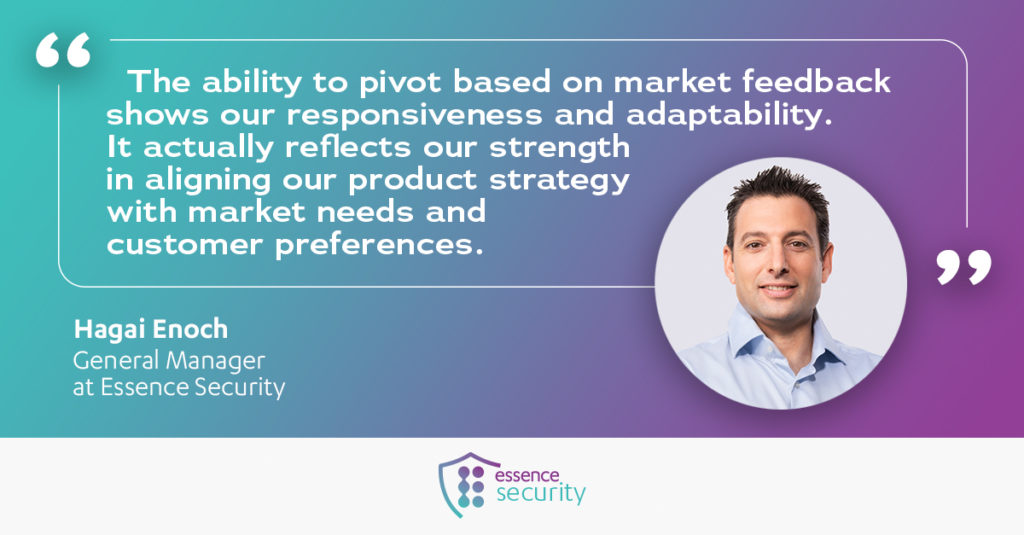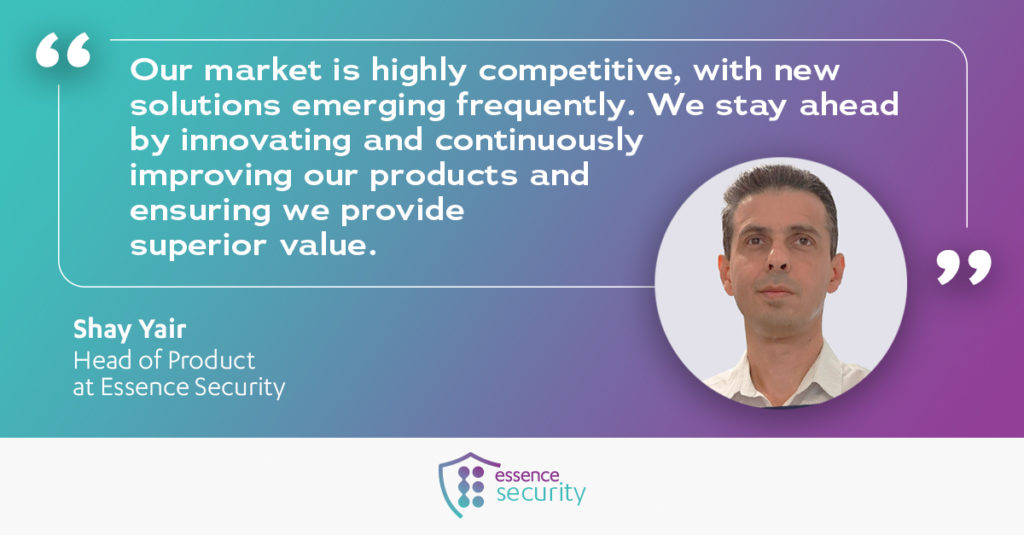
Following our recent introduction of MyShield’s new versions we took the opportunity to talk to key experts at Essence Security about our process for developing new features and products. Rafi Zauer, our Head of Marketing, recently sat down with Hagai Enoch, General Manager, Rami Ziv, VP of Business Development, and Shay Yair, Head of Product Management, to gain valuable insights into how we approach innovation and product development.
Participants:
- Hagai Enoch (H), GM at Essence Security
- Rami Ziv (R), VP of Business Development
- Shay Yair (S), Head Of Product Management
- Interviewer (I) Rafi Zauer, Head of Marketing
I: Let’s discuss the process of how you bring new features or new products to market. How does customer feedback help you to understand and process the main requirements for new products and missing features to develop?
R: It’s pretty straightforward. When I meet with customers, I demonstrate our products and listen to their reactions. Their questions and concerns provide valuable feedback. For example, if multiple customers ask for a feature, I note it down. Recurring questions like “Can this integrate with my current system?” or “How can we schedule arming and disarming?” highlight essential features we need to consider. Feedback ranges from practical requests, like better integration with existing systems, to subjective ones, like specific product issues. We prioritize based on how common and critical the feedback is.
I: How do you decide if a feedback point is significant enough to act upon?
R: I put myself in the customer’s shoes. If our prospect in Spain asks, “Can this be in Spanish?” I understand it’s essential for them. Practical requests, like integrations, are obviously critical. However, subjective feedback, like size concerns, might be less actionable unless it’s repeated by many customers. For example, if several clients want a camera-free version of MyShield, I push this feedback to the product team. Part of my job, as I see it, is to advocate for the customer.
I: Shay, as Head of Product, how do you handle feedback and incorporate it into the product roadmap?
S: I gather feedback from various sources: Business Development, our sales team, account managers, customer support, and sometimes directly from customers. We evaluate each request by complexity, using a ‘T-shirt size’ method (e.g., S, M, L). Simple requests, like changing a button’s design in the app, can be quickly addressed. More complex ones, like integrations and app features such as smart rules, require significant development and are prioritized based on careful planning and consultation with our CEO, Hagai, on their business impact.
I: Hagai, can you expand on how business impact influences your decisions?
H: We evaluate market demand and the potential return on investment (ROI). Not every feedback leads to immediate action. However, significant, recurring requests are prioritized. For instance, when a Swiss client requested specific features that were easily translated into ROI, we quickly prioritized this request despite it being a unique case. We balance immediate customer needs with long-term business goals. Moreover, when we consider implementing new features versus creating entirely new products, we focus on feedback that aligns with our core strengths and market positioning.
I: So, what motivated the development of new versions of MyShield?
R: Customer feedback revealed a need for a simpler, smoke-deterrent-only device without features like the camera because many of them already deploy security system with multiple peripherals, including cameras. Our conclusion is that they were looking for a single-feature smoke security device that is a simple add-on to existing alarm systems. This led us to develop a more affordable, streamlined product. It’s about adapting to specific market demands while leveraging our existing technology.
S: The company’s business concept at the outset that this product was built for another market segment as an all-in-one device that provides a holistic solution as a standalone security system. Over time, we recognized the opportunity to expand its reach without compromising its original value.
R: One of the most recurring feedback items from prospects was that while MyShield is excellent in its niche, it could benefit from adaptations to a variety of diverse environments to expand its market reach. This feedback showed us that there was a potential for expanding the range of devices tailored to versatile security needs.
S: Exactly. This is a really great product, but it is not always needed as a standalone and all-in-one solution. It can also serve as an add-on device to existing security systems that already have cameras, PIR motion detection, etc. Many security providers or integrators saw the value in MyShield, and they were very excited to have a product line to choose from depending on a specific use case whether they need a standalone device or a supplementary smoke deterrent device to enhance an existing alarm system. Realizing this, we understood there’s a massive interest in an integrated smoke canister device as well as in an all-in-one solution in the professionally monitored segment of the security market.
I: Is the fact that originally we designed MyShield as an all-in-one device but have now expanded to include a range of products for different use cases reflect a weakness in our initial concept? Was there something wrong with our process from the start? Or is this a legitimate part of the development process?
H: Not at all. It’s a legitimate part of the development process. The ability to pivot based on market feedback shows our responsiveness and adaptability. Initially, our concept aimed at a comprehensive solution, but market feedback indicated a strong demand for an integrated smoke deterrent device. This pivot actually reflects our strength in aligning our product strategy with market needs and customer preferences. Every company aiming for success does it the same way.
S: Our initial standalone product concept evolved based on market feedback into a versatile smoke deterrent product line with flexible installation and integration options. This shift allows us to meet broader needs and maintain a competitive edge. For example, while many competitors offer basic third-party integration only, we provide more flexible and comprehensive options, meeting diverse customer requirements.
I: Can you elaborate on how competitor and market analysis impacts your decision-making in developing new features or products?
H: Understanding your competitive environment is crucial. We constantly monitor what our competitors are doing and how they’re positioning their products. Being clued-in to the competitive landscape helps us identify gaps in the market and areas where we can differentiate ourselves and offer a product with the features that nobody else has. For instance, if a competitor introduces a new feature that gains traction, we evaluate its feasibility and potential impact on our products.
S: Our market is highly competitive, with new solutions emerging frequently. We stay ahead by innovating and continuously improving our products and ensuring we provide superior value. While analyzing the market we discovered that most of our competitors offer 3rd party basic integration capabilities. So, we knew that this feature is expected by our prospects. We adopted this idea and developed it even further with high priority. We decided to offer operation and deployment flexibility through multiple integration options.
I: Rami, do you think it is important to initiate meetings with customers or prospects as a crucial aspect for product improvement?
R: Definitely. Surveys are very important to gather initial feedback, hearing their likes and dislikes, and recommendations. However, face-to-face meetings offer more nuanced insights and actual first reaction. Observing customers during demos or meetings reveals what truly matters to them, guiding our development process.
H: It depends on the stage of collaboration. Surveys are particularly relevant for customers with a long relationship history, where they can provide detailed and thoughtful feedback and what really matters to them. However, they might not be as effective with prospects who are still evaluating our products during demos or pilot stages. Direct verbal feedback is often more detailed and honest. But, of course, not every request from every client is actionable. We prioritize requests that bring added value to us and our customers, improving their experience and expanding our market. It’s about understanding which requests align with our strategic goals and offer significant improvements to our products.
The insights shared by our panel of experts underscore that we’ve thoughtfully navigated our decisions and developed a solution that meets market needs. We’ve genuinely enjoyed the process and are committed to continuously learning from our customers’ feedback, in the process of our future innovation developments.



